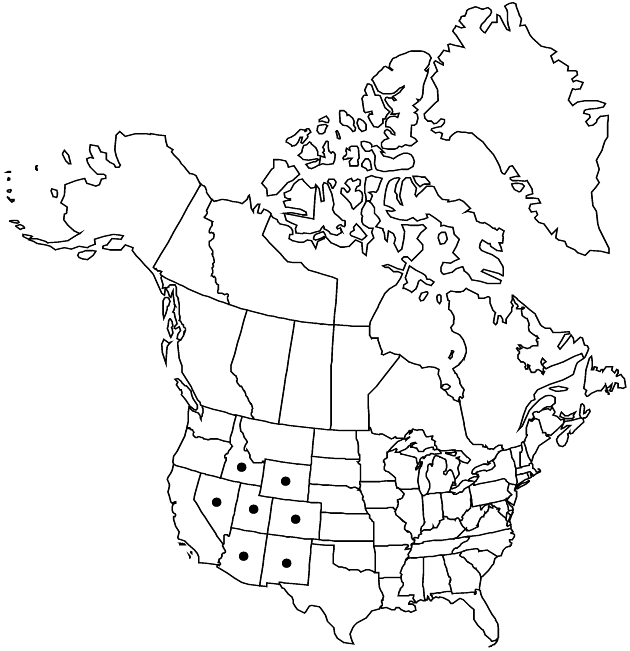Difference between revisions of "Lygodesmia grandiflora"
Fl. N. Amer. 2: 485. 1843.
FNA>Volume Importer |
RevisionBot (talk | contribs) m (Bot: Adding category Revised Since Print) |
||
| (7 intermediate revisions by 3 users not shown) | |||
| Line 8: | Line 8: | ||
}} | }} | ||
|common_names=Largeflower skeletonplant | |common_names=Largeflower skeletonplant | ||
| − | |basionyms={{Treatment/ID/ | + | |special_status={{Treatment/ID/Special_status |
| + | |code=E | ||
| + | |label=Endemic | ||
| + | }} | ||
| + | |basionyms={{Treatment/ID/Basionym | ||
|name=Erythremia grandiflora | |name=Erythremia grandiflora | ||
|authority=Nuttall | |authority=Nuttall | ||
| + | |rank=species | ||
| + | |publication_title=Trans. Amer. Philos. Soc., n. s. | ||
| + | |publication_place=7: 445. 1841 | ||
}} | }} | ||
|synonyms= | |synonyms= | ||
| Line 23: | Line 30: | ||
-->{{Treatment/Body | -->{{Treatment/Body | ||
| − | |distribution= | + | |distribution=Ariz.;Colo.;Idaho;N.Mex.;Nev.;Utah;Wyo. |
|discussion=<p>Varieties 5 (5 in the flora).</p><!-- | |discussion=<p>Varieties 5 (5 in the flora).</p><!-- | ||
--><p><i>Lygodesmia grandiflora</i> is recognized mainly by its relatively large corollas. Some variants were segregated as distinct species by A. S. Tomb; because of intermediates, putative hybrids, and associated identification problems, it is probably best to recognize these as varieties pending further investigation (A. Cronquist 1994; S. L. Welsh et al. 2003).</p> | --><p><i>Lygodesmia grandiflora</i> is recognized mainly by its relatively large corollas. Some variants were segregated as distinct species by A. S. Tomb; because of intermediates, putative hybrids, and associated identification problems, it is probably best to recognize these as varieties pending further investigation (A. Cronquist 1994; S. L. Welsh et al. 2003).</p> | ||
| Line 72: | Line 79: | ||
-->{{#Taxon: | -->{{#Taxon: | ||
name=Lygodesmia grandiflora | name=Lygodesmia grandiflora | ||
| − | |||
|authority=(Nuttall) Torrey & A. Gray | |authority=(Nuttall) Torrey & A. Gray | ||
|rank=species | |rank=species | ||
| Line 79: | Line 85: | ||
|basionyms=Erythremia grandiflora | |basionyms=Erythremia grandiflora | ||
|family=Asteraceae | |family=Asteraceae | ||
| − | |distribution= | + | |distribution=Ariz.;Colo.;Idaho;N.Mex.;Nev.;Utah;Wyo. |
|reference=None | |reference=None | ||
|publication title=Fl. N. Amer. | |publication title=Fl. N. Amer. | ||
|publication year=1843 | |publication year=1843 | ||
| − | |special status= | + | |special status=Endemic |
| − | |source xml=https:// | + | |source xml=https://bitbucket.org/aafc-mbb/fna-data-curation/src/2e0870ddd59836b60bcf96646a41e87ea5a5943a/coarse_grained_fna_xml/V19-20-21/V19_593.xml |
|tribe=Asteraceae tribe Cichorieae | |tribe=Asteraceae tribe Cichorieae | ||
|genus=Lygodesmia | |genus=Lygodesmia | ||
| Line 90: | Line 96: | ||
}}<!-- | }}<!-- | ||
| − | -->[[Category:Treatment]][[Category:Lygodesmia]] | + | --> |
| + | |||
| + | [[Category:Treatment]] | ||
| + | [[Category:Lygodesmia]] | ||
| + | [[Category:Revised Since Print]] | ||
Latest revision as of 18:30, 6 November 2020
Perennials 5–25(–60) cm; roots or rhizomes vertical, deep. Stems 1–5, erect or ascending, green, simple or branched from bases, obscurely striate (glabrous, puberulent or scabrous). Leaves (basal not forming rosettes, cauline present at flowering); basal blades linear to subulate, 5–150 × 1–6 mm, margins entire; cauline similar, sometimes reduced to scales distally. Heads (1–30, showy) borne singly or in loose, corymbiform arrays. Involucres cylindric, 15–25 × 6–8 mm, apices narrowed or spreading. Calyculi of ca. 8, deltate to ovate bractlets 2–5 mm, margins ciliate (faces tomentulose). Phyllaries 5–12, linear, 15–24 mm, margins scarious, apices appendaged (faces glabrous or scabrous). Florets 5–12; corollas 20–40 mm, lavender, pink, purple, rose, or white, ligules 5–10 mm wide. Cypselae (subcylindric, obscurely 4–5-angled) 10–18 mm (faces smooth or rugose, sometimes sulcate); pappi 10–13 mm. 2n = 18.
Distribution

Ariz., Colo., Idaho, N.Mex., Nev., Utah, Wyo.
Discussion
Varieties 5 (5 in the flora).
Lygodesmia grandiflora is recognized mainly by its relatively large corollas. Some variants were segregated as distinct species by A. S. Tomb; because of intermediates, putative hybrids, and associated identification problems, it is probably best to recognize these as varieties pending further investigation (A. Cronquist 1994; S. L. Welsh et al. 2003).
Selected References
None.
Lower Taxa
Key
| 1 | Phyllaries 8–12; florets 8–12 | Lygodesmia grandiflora var. grandiflora |
| 1 | Phyllaries 5(–6); florets 5(–7) | > 2 |
| 2 | Corollas white (may turn pinkish when dry); stems (woody) branched from bases; leaves stiff, spreading; involucre apices spreading | Lygodesmia grandiflora var. entrada |
| 2 | Corollas lavender, pink, purple, rose, or white; stems simple or branched from bases or distally (if branched from bases, either leaves lax or plants from vicinity of Moab, Utah); involucre apices narrow | > 3 |
| 3 | Stems much branched from bases; proximal leaves narrow, linear-filiform, 1–3 mm wide, rigid | Lygodesmia grandiflora var. doloresensis |
| 3 | Stems simple or sparsely branched from bases or distally; proximal leaves lanceolate to linear-subulate, (2–)3–6 mm wide, ± lax (widespread in southwestern states). | > 4 |
| 4 | Distal leaves not reduced to scales (mostly 10+ mm); cypselae 10–13 mm, abaxial faces rugose, adaxial faces strongly sulcate | Lygodesmia grandiflora var. arizonica |
| 4 | Distal leaves reduced to linear scales (mostly less than 10 mm); cypselae 13–19 mm, abaxial faces smooth, adaxial faces weakly sulcate | Lygodesmia grandiflora var. dianthopsis |